工程热力学 课后习题答案 可打印 第三版 第二章
- 格式:pdf
- 大小:441.13 KB
- 文档页数:8
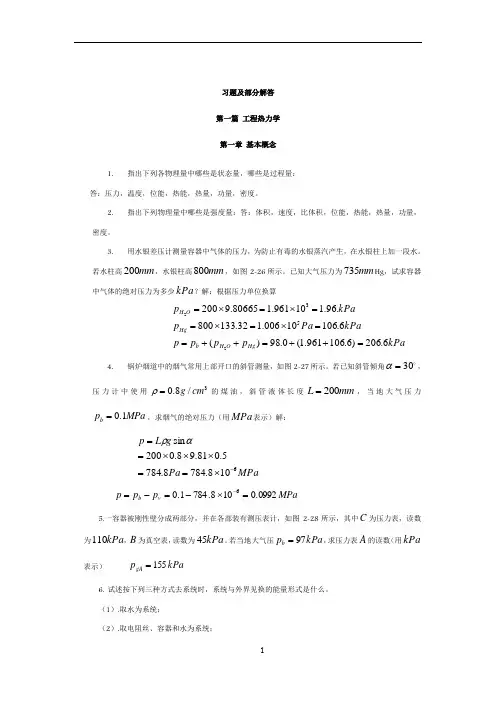
习题及部分解答第一篇 工程热力学 第一章 基本概念1. 指出下列各物理量中哪些是状态量,哪些是过程量:答:压力,温度,位能,热能,热量,功量,密度。
2. 指出下列物理量中哪些是强度量:答:体积,速度,比体积,位能,热能,热量,功量,密度。
3.用水银差压计测量容器中气体的压力,为防止有毒的水银蒸汽产生,在水银柱上加一段水。
若水柱高mm 200,水银柱高mm 800,如图2-26所示。
已知大气压力为mm 735Hg ,试求容器中气体的绝对压力为多少kPa ?解:根据压力单位换算kPap p p p kPaPa p kPa p Hg O H b Hg O H 6.206)6.106961.1(0.98)(6.10610006.132.133800.96.110961.180665.92002253=++=++==⨯=⨯==⨯=⨯=4.锅炉烟道中的烟气常用上部开口的斜管测量,如图2-27所示。
若已知斜管倾角 30=α,压力计中使用3/8.0cm g =ρ的煤油,斜管液体长度mm L 200=,当地大气压力MPa p b 1.0=,求烟气的绝对压力(用MPa 表示)解:MPaPa g L p 6108.7848.7845.081.98.0200sin -⨯==⨯⨯⨯==αρMPa p p p v b 0992.0108.7841.06=⨯-=-=-5.一容器被刚性壁分成两部分,并在各部装有测压表计,如图2-28所示,其中C 为压力表,读数为kPa 110,B 为真空表,读数为kPa 45。
若当地大气压kPa p b 97=,求压力表A 的读数(用kPa表示)kPa p gA 155=6. 试述按下列三种方式去系统时,系统与外界见换的能量形式是什么。
(1).取水为系统;(2).取电阻丝、容器和水为系统;(3).取图中虚线内空间为系统。
答案略。
7.某电厂汽轮机进出处的蒸汽用压力表测量,起读数为MPa 4.13;冷凝器内的蒸汽压力用真空表测量,其读数为mmHg 706。
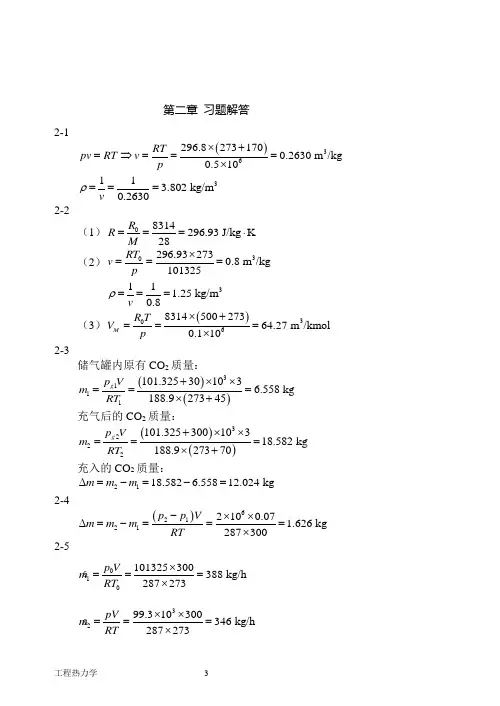
第二章 习题解答 2-1()36296.82731700.2630 m /kg 0.510RT pv RT v p ⨯+=⇒===⨯ 311 3.802 kg/m 0.2630v ρ=== 2-2 (1)08314296.93 J/kg K 28R R M ===⋅ (2)30296.932730.8 m /kg 101325RT v p ⨯=== 311 1.25 kg/m 0.8v ρ=== (3)()306831450027364.27 m /kmol 0.110M R T V p ⨯+===⨯ 2-3储气罐内原有CO 2质量:()()3111101.32530103 6.558 kg 188.927345g p V m RT +⨯⨯===⨯+ 充气后的CO 2质量:()()3222101.32530010318.582 kg 188.927370g p V m RT +⨯⨯===⨯+ 充入的CO 2质量:2118.582 6.55812.024 kg m m m ∆=-=-=2-4()621212100.07 1.626 kg 287300p p V m m m RT -⨯⨯∆=-===⨯ 2-5010101325300388 kg/h 287273p V m RT ⨯===⨯ 3299.310300346 kg/h 287273pV m RT ⨯⨯===⨯2-6充入的空气在室外状态下体积:()3220.80.18.559.5 m 0.1pV V p -⨯∆=== 59.519.83 min 3τ== 2-7()()350011011010014310115.210 1.0210273101325300273 5.57310 m /hp V pVT pV V T T p T +⨯⨯⨯⨯=⇒==⨯+=⨯ 2-8 表压力:230009.807234 kPa 0.44g p π⨯==⨯ 101234335 kPa g p B p =+=+=(1)压力不变()2211227318582 K V T T V ==⨯+==309℃ (2)32232875820.5 m /kg 33510RT v p ⨯===⨯ (3)终态:32211 2 kg/m 0.5v ρ=== 初态:3122 4 kg/m ρρ==2-9(1)613.7100.057.693 kg 296.8300pV m RT ⨯⨯===⨯ (2)1222112116.5300361 K 13.7p V p V p T T T T p =⇒==⨯= 2-10111m RT V p = 6212126212250.361030318.6 kg 0.510293p V m p T m RT p T ⨯⨯⨯====⨯⨯2-11333440.15243.140.00185 m 332V R π⎛⎫==⨯⨯= ⎪⎝⎭ 537.6100.001852083 J/kg K 2.2510300pV R mT -⨯⨯===⋅⨯⨯ 该气体为氦气2-12 其他条件相同时,压力低、温度高所需体积大。
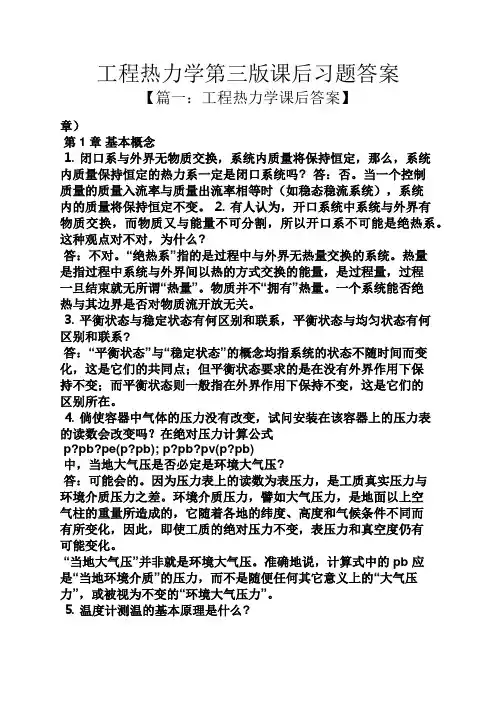
工程热力学第三版课后习题答案【篇一:工程热力学课后答案】章)第1章基本概念⒈闭口系与外界无物质交换,系统内质量将保持恒定,那么,系统内质量保持恒定的热力系一定是闭口系统吗? 答:否。
当一个控制质量的质量入流率与质量出流率相等时(如稳态稳流系统),系统内的质量将保持恒定不变。
⒉有人认为,开口系统中系统与外界有物质交换,而物质又与能量不可分割,所以开口系不可能是绝热系。
这种观点对不对,为什么?答:不对。
“绝热系”指的是过程中与外界无热量交换的系统。
热量是指过程中系统与外界间以热的方式交换的能量,是过程量,过程一旦结束就无所谓“热量”。
物质并不“拥有”热量。
一个系统能否绝热与其边界是否对物质流开放无关。
⒊平衡状态与稳定状态有何区别和联系,平衡状态与均匀状态有何区别和联系?答:“平衡状态”与“稳定状态”的概念均指系统的状态不随时间而变化,这是它们的共同点;但平衡状态要求的是在没有外界作用下保持不变;而平衡状态则一般指在外界作用下保持不变,这是它们的区别所在。
⒋倘使容器中气体的压力没有改变,试问安装在该容器上的压力表的读数会改变吗?在绝对压力计算公式p?pb?pe(p?pb); p?pb?pv(p?pb)中,当地大气压是否必定是环境大气压?答:可能会的。
因为压力表上的读数为表压力,是工质真实压力与环境介质压力之差。
环境介质压力,譬如大气压力,是地面以上空气柱的重量所造成的,它随着各地的纬度、高度和气候条件不同而有所变化,因此,即使工质的绝对压力不变,表压力和真空度仍有可能变化。
“当地大气压”并非就是环境大气压。
准确地说,计算式中的pb 应是“当地环境介质”的压力,而不是随便任何其它意义上的“大气压力”,或被视为不变的“环境大气压力”。
⒌温度计测温的基本原理是什么?答:温度计对温度的测量建立在热力学第零定律原理之上。
它利用了“温度是相互热平衡的系统所具有的一种同一热力性质”,这一性质就是“温度”的概念。
⒍经验温标的缺点是什么?为什么?答:由选定的任意一种测温物质的某种物理性质,采用任意一种温度标定规则所得到的温标称为经验温标。
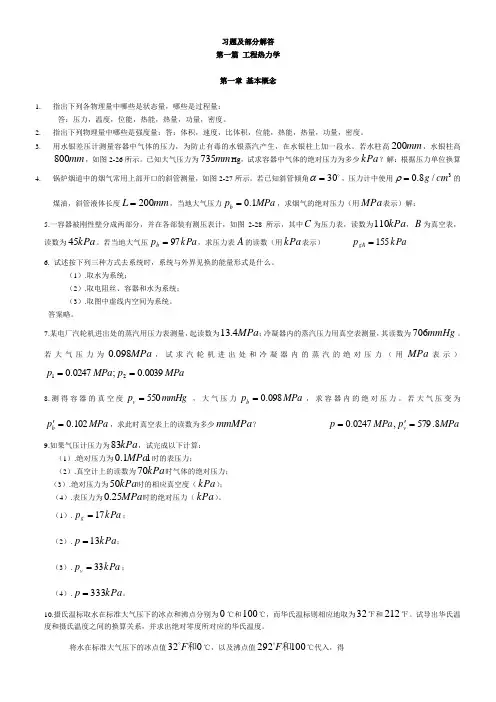

工程热力学习题解答工程热力学习题解答第1章 基本概念基本概念1-1体积为2L 的气瓶内盛有氧气2.858g,求氧气的比体积、密度和重度。
解:氧气的比体积为3310858.2102−−××==m V v =0.6998 m 3/kg密度为vm V 110210858.233=××==−−ρ=1.429 kg/m 3重度80665.9429.1×==g ργ=14.01 N/m 31-2某容器被一刚性器壁分为两部分,在容器的不同部分安装了测压计,如图所示。
压力表A 的读数为0.125MPa,压力表B 的读数为0.190 MPa,如果大气压力为0.098 MPa,试确定容器两部分气体的绝对压力可各为多少?表C 是压力表还是真空表?表C的读数应是多少?解:设表A、B、C 读出的绝对压力分别为A p 、B p 和C p 。
则根据题意,有容器左侧的绝对压力为=+=+==125.0098.0gA b A p p p p 左0.223 MPa 又∵容器左侧的绝对压力为gB C B p p p p +==左 ∴033.0190.0223.0gB C =−=−=p p p 左 MPa<b p∴表C 是真空表,其读数为033.0098.0C b vC −=−=p p p =0.065 MPa 则容器右侧的绝对压力为=−=−=065.0098.0vC b p p p 右0.033 MPa1-3上题中,若表A 为真空表,其读数为24.0kPa,表B 的读数为0.036 MPa,试确定表C 的读数。
解:则根据题意,有容器左侧的绝对压力为=−=−==024.0098.0vA b A p p p p 左0.074 MPa 若表B 为压力表,则容器左侧的绝对压力为gB C B p p p p +==左 ∴038.0036.0074.0gB C =−=−=p p p 左 MPa<b p∴表C 是真空表,其读数为038.0098.0C b vC −=−=p p p =0.060 MPa 则容器右侧的绝对压力为=−=−=060.0098.0vC b p p p 右0.038 MPa 若表B 为真空表,则容器左侧的绝对压力为vB C B p p p p −==左习题1-2图∴110.0036.0074.0vB C =+=+=p p p 左 MPa>b p∴表C 是压力表,其读数为098.0110.0b C gC −=−=p p p =0.012 MPa1-4由于水银蒸气对人体组织有害,所以在水银柱面上常注入一段水,以防止水银蒸气发生。
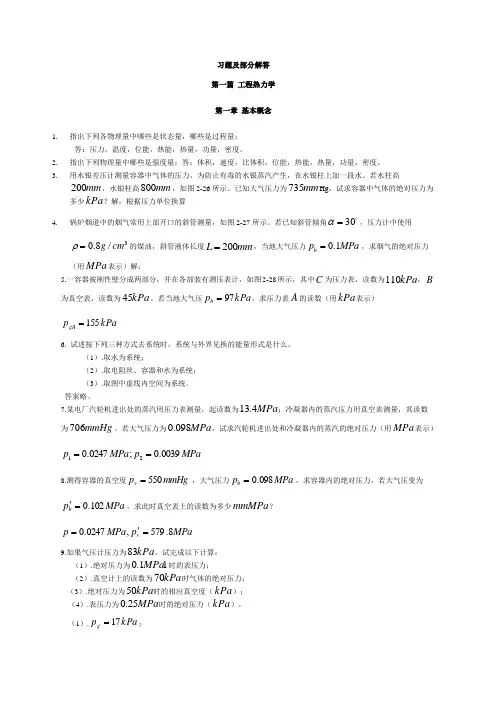
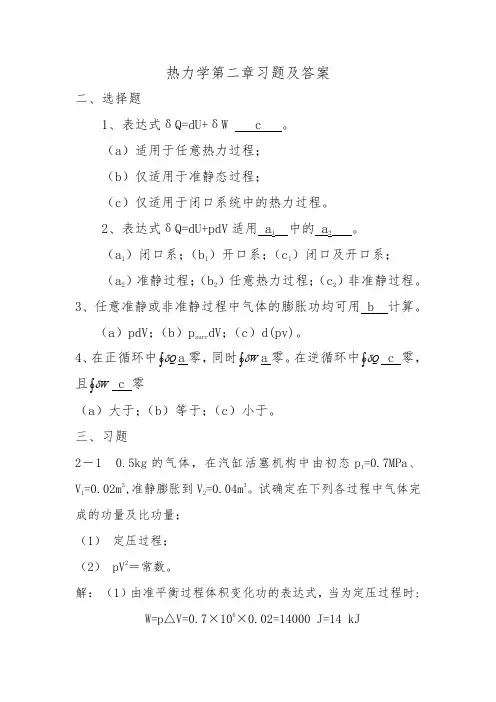
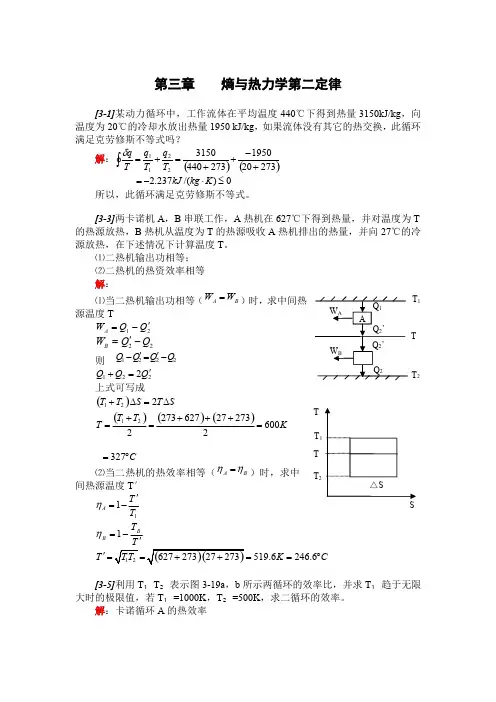
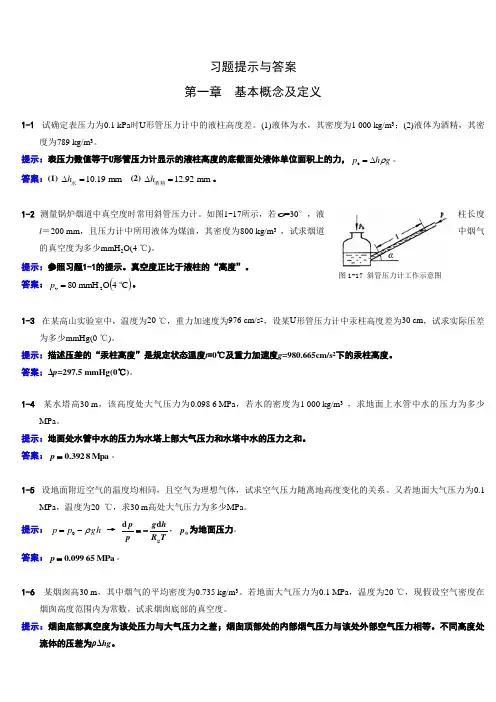
习题提示与答案 第一章 基本概念及定义1-1 试确定表压力为0.1 kPa 时U 形管压力计中的液柱高度差。
(1)液体为水,其密度为1 000 kg/m 3;(2)液体为酒精,其密度为789 kg/m 3。
提示:表压力数值等于U 形管压力计显示的液柱高度的底截面处液体单位面积上的力,g h p ρ∆=e 。
答案:(1) mm 10.19=∆水h (2) mm 12.92=∆酒精h 。
1-2 测量锅炉烟道中真空度时常用斜管压力计。
如图1-17所示,若α=30°,液柱长度l =200 mm ,且压力计中所用液体为煤油,其密度为800 kg/m 3 ,试求烟道中烟气的真空度为多少mmH 2O(4 ℃)。
提示:参照习题1-1的提示。
真空度正比于液柱的“高度”。
答案:()C 4O mmH 802v=p 。
1-3 在某高山实验室中,温度为20 ℃,重力加速度为976 cm/s 2,设某U 形管压力计中汞柱高度差为30 cm ,试求实际压差为多少mmHg(0 ℃)。
提示:描述压差的“汞柱高度”是规定状态温度t =0℃及重力加速度g =980.665cm/s 2下的汞柱高度。
答案:Δp =297.5 mmHg(0℃)。
1-4 某水塔高30 m ,该高度处大气压力为0.098 6 MPa ,若水的密度为1 000 kg/m 3 ,求地面上水管中水的压力为多少MPa 。
提示:地面处水管中水的压力为水塔上部大气压力和水塔中水的压力之和。
答案:Mpa 8 0.392=p 。
1-5 设地面附近空气的温度均相同,且空气为理想气体,试求空气压力随离地高度变化的关系。
又若地面大气压力为0.1MPa ,温度为20 ℃,求30 m 高处大气压力为多少MPa 。
提示: h g p p ρ-=0 →TR hg p p g d d -=,0p 为地面压力。
答案:MPa 65099.0=p 。
1-6 某烟囱高30 m ,其中烟气的平均密度为0.735 kg/m 3。
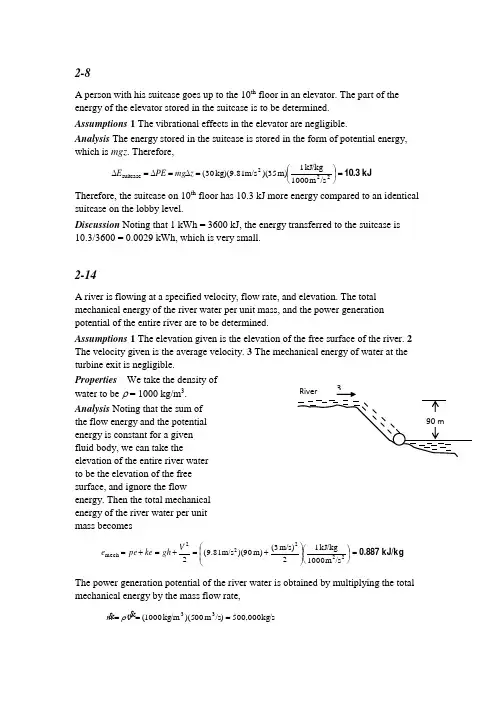
2-8A person with his suitcase goes up to the 10th floor in an elevator. The part of the energy of the elevator stored in the suitcase is to be determined. Assumptions 1 The vibrational effects in the elevator are negligible.Analysis The energy stored in the suitcase is stored in the form of potential energy, which is mgz . Therefore,kJ 10.3=⎪⎭⎫⎝⎛=∆=∆=∆222suitcase /s m 1000 kJ/kg 1m) 35)(m/s(9.81) kg (30z mg PE ETherefore, the suitcase on 10th floor has 10.3 kJ more energy compared to an identical suitcase on the lobby level.Discussion Noting that 1 kWh = 3600 kJ, the energy transferred to the suitcase is 10.3/3600 = 0.0029 kWh, which is very small.2-14A river is flowing at a specified velocity, flow rate, and elevation. The total mechanical energy of the river water per unit mass, and the power generation potential of the entire river are to be determined.Assumptions 1 The elevation given is the elevation of the free surface of the river. 2 The velocity given is the average velocity. 3 The mechanical energy of water at the turbine exit is negligible. Properties We take the density of water to be ρ = 1000 kg/m 3. Analysis Noting that the sum of the flow energy and the potential energy is constant for a given fluid body, we can take theelevation of the entire river water to be the elevation of the free surface, and ignore the flowenergy. Then the total mechanical energy of the river water per unit mass becomesk J /k g 0.887=⎪⎭⎫ ⎝⎛⎪⎪⎭⎫ ⎝⎛+=+=+=22222me ch /s m 1000kJ/kg 12)m/s 3(m) 90)(m/s (9.812Vgh ke pe e The power generation potential of the river water is obtained by multiplying the totalmechanical energy by the mass flow rate,kg/s500,000/s)m 00)(5 kg/m 1000(33===V ρmMW444=====kW 000,444kJ/kg) 7kg/s)(0.88 000,500(mech mech max e m E WTherefore, 444 MW of power can be generated from this river as it discharges into thelake if its power potential can be recovered completely.Discussion Note that the kinetic energy of water is negligible compared to the potential energy, and it can be ignored in the analysis. Also, the power output of an actual turbine will be less than 444 MW because of losses and inefficiencies.2-21C(a ) From the perspective of the contents, heat must be removed in order to reduce and maintain the content's temperature. Heat is also being added to the contents from the room air since the room air is hotter than the contents.(b ) Considering the system formed by the refrigerator box when the doors are closed, there are three interactions, electrical work and two heat transfers. There is atransfer of heat from the room air to the refrigerator through its walls. There is also a transfer of heat from the hot portions of the refrigerator (i.e., back of the compressor where condenser is placed) system to the room air. Finally, electrical work is being added to the refrigerator through the refrigeration system.(c ) Heat is transferred through the walls of the room from the warm room air to the cold winter air. Electrical work is being done on the room through the electrical wiring leading into the room.2-27A man is pushing a cart with its contents up a ramp that is inclined at an angle of 10° from the horizontal. The work needed to move along this ramp is to be determined considering (a) the man and (b) the cart and its contents as the system.Analysis (a ) Considering the man as the system, letting l be the displacement along the ramp, and letting θ be the inclination angle of the ramp,Btu6.248ft lbf 4862=⎪⎭⎫⎝⎛⋅⋅=⋅=+==ft lbf 169.778Btu 1ft)lbf 4862(ft)sin(10) 100)(lbf 180100(sin θFl WThis is work that the man must do to raise the weight of the cart and contents, plus hisown weight, a distance of l sin θ.(b ) Applying the same logic to the cart and its contents givesBtu2.231ftlbf 1736=⎪⎭⎫⎝⎛⋅⋅=⋅===ft lbf 169.778Btu 1ft)lbf 1736(ft)sin(10) 100)(lbf 100(sin θFl W2-30The work required to compress a spring is to be determined.Analysis The force at any point during the deflection of the spring is given by F = F 0 + kx , where F 0 is the initial force and x is the deflection as measured from the point where the initial force occurred. From the perspective of the spring, this force acts in the direction opposite to that in which the spring is deflected. Then,[]Btu0.0214=⎪⎭⎫⎝⎛⎪⎭⎫ ⎝⎛⋅⋅=⋅=-+-=-+-=+==⎰⎰in 12ft 1ft lbf 169.778Btu 1in)lbf 200(inlbf 200in)01(2lbf/in2000)in (1lbf) 100()(2)()(22221221202121x x k x x F dx kx FFds W2-43The classrooms and faculty offices of a university campus are not occupied anaverage of 4 hours a day, but the lights are kept on. The amounts of electricity and money the campus will save per year if the lights are turned off during unoccupied periods are to be determined.Analysis The total electric power consumed by the lights in the classrooms and faculty offices iskW528264264kW 264264,000= W)1106(400=lamps) of (mp)per consumed (Power kW264264,000= W)11012(200=lamps) of (mp)per consumed (Power officeslighting,classroomlighting,totallighting,offices lighting,classroom lighting,=+=+==⨯⨯⨯==⨯⨯⨯=E E E E ENoting that the campus is open 240 days a year, the total number of unoccupiedwork hours per year isUnoccupied hours = (4 hours/day)(240 days/year) = 960 h/yrThen the amount of electrical energy consumed per year during unoccupied work period and its cost are$41,564/yr======.082/kWh)kWh/yr)($0 506,880(energy) of cost nit savings)(U (Energy savings Cost kWh506,880h/yr) kW)(960 (528hours) Unoccupied )((savings Energy totallighting,EDiscussion Note that simple conservation measures can result in significant energyand cost savings.2-47A gasoline pump raises the pressure to a specified value while consuming electric power at a specified rate. The maximum volume flow rate of gasoline is to be determined.Assumptions 1 The gasoline pump operates steadily. 2 The changes in kinetic and potential energies across the pump are negligible.Analysis For a control volume that encloses the pump-motor unit, the energy balance can be written as/energiesetc. potential, k inetic, internal,in change of Rate (steady)0system massand work ,heat,by nsferenergy tra net of Rate out in ==-dtdE E E →outin E E =21in)()(v v P m P m W =+ →P P P m W ∆=-= V v )(12insince /v V =mand the changes in kinetic and potential energies of gasoline are negligible, Solving for volume flow rate and substituting, the maximum flow rate is determined to be/s m 0.5433=⎪⎪⎭⎫⎝⎛⋅=∆=kJ 1mkPa 1kPa 7kJ/s 8.3P 3inmaxWVDiscussion The conservation of energy principle requires the energy to be conserved as it is converted from one form to another, and it does not allow any energy to be created or destroyed during a process. In reality, the volume flow rate will be less because of the losses associated with the conversion of electrical-to-mechanical shaft and mechanical shaft-to-flow energy.2-65Water is pumped from a lake to a storage tank at a specified rate. The overall efficiency of the pump-motor unit and the pressure difference between the inlet and the exit of the pump are to be determined.Assumptions 1 The elevations of the tank and the lake remain constant. 2 Frictional losses in the pipes are negligible. 3 The changes in kinetic energy are negligible. 4 The elevation difference across the pump is negligible.Properties We take the density of water to be ρ = 1000 kg/m 3. Analysis (a ) We take the free surface of the lake to be point 1 and the free surfaces of the storage tank to be point 2. We also take the lake surface as the reference level (z 1 = 0), and thus the potential energy at points 1and 2 are pe 1 = 0 and pe 2 = gz 2. The flow energy at both points is zero since both 1 and 2 are open to the atmosphere (P 1 = P 2 = P atm ). Further, the kinetic energy at both points is zero (ke 1 = ke 2 = 0) since the water at both locations is essentiallystationary. The mass flow rate of water and its potential energy at point 2 are k g /s70/s)m 070.0)( kg/m 1000(33===V ρmk J /k g 196.0/s m 1000 kJ/kg 1m) 20)(m/s(9.8122222=⎪⎭⎫⎝⎛==gz pe Then the rate of increase of the mechanical energy of water becomeskW13.7kJ/kg) 6kg/s)(0.19 70()0()(22in mech,out mech,fluid mech,===-=-=∆pe m pe m e e m EThe overall efficiency of the combined pump-motor unit is determined from itsdefinition,67.2%or 0.672 kW20.4 kW 7.13inelect,fluid mech,motor-pump==∆=W E η(b ) Now we consider the pump. The change in the mechanical energy of water as itflows through the pump consists of the change in the flow energy only since the elevation difference across the pump and the change in the kinetic energy arenegligible. Also, this change must be equal to the useful mechanical energy supplied by the pump, which is 13.7 kW:P P P me e m E ∆=-=-=∆V ρ12in mech,out mech,fluid mech,)(Solving for ∆P and substituting,kPa 196=⎪⎪⎭⎫⎝⎛⋅=∆=∆ kJ 1m kPa 1/s m 0.070 kJ/s13.733fluidmech,VE PTherefore, the pump must boost the pressure of water by 196 kPa in order to raise its elevation by 20 m.Discussion Note that only two-thirds of the electric energy consumed by the pump-motor is converted to the mechanical energy of water; the remaining one-third is wasted because of the inefficiencies of the pump and the motor .2-112The work required to compress a gas in a gas spring is to be determined.Assumptions All forces except that generated by the gas spring will be neglected.Analysis When the expression given in the problem statement is substituted into the work integral relation, and advantage is taken of the fact that the force and displacement vectors are collinear, the result is[]Btu0.0228=⎪⎭⎫⎝⎛⋅⋅=⋅=⎪⎭⎫ ⎝⎛--⋅=--===----⎰⎰ft lbf 169.778Btu 1ft)lbf 74.17(ftlbf 74.17in 12ft 1 in)1(in)4(4.11inlbf 200)(1Constant Constant0.40.41.411122121k k kx x k dxxFds W。
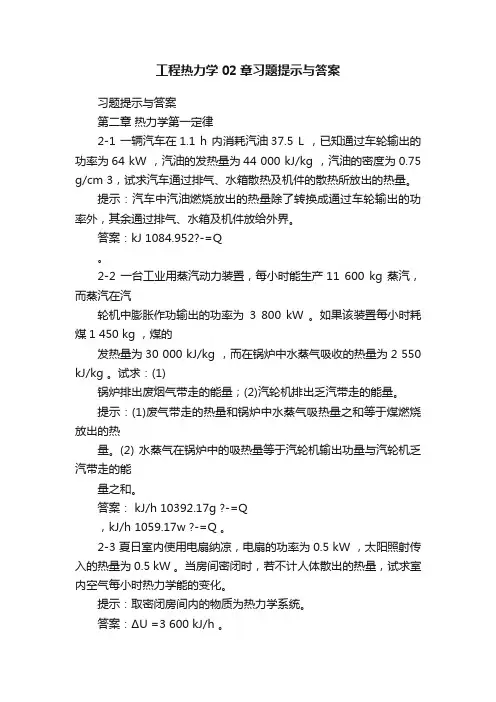
工程热力学02章习题提示与答案习题提示与答案第二章热力学第一定律2-1 一辆汽车在1.1 h 内消耗汽油37.5 L ,已知通过车轮输出的功率为64 kW ,汽油的发热量为44 000 kJ/kg ,汽油的密度为0.75 g/cm 3,试求汽车通过排气、水箱散热及机件的散热所放出的热量。
提示:汽车中汽油燃烧放出的热量除了转换成通过车轮输出的功率外,其余通过排气、水箱及机件放给外界。
答案:kJ 1084.952?-=Q。
2-2 一台工业用蒸汽动力装置,每小时能生产11 600 kg 蒸汽,而蒸汽在汽轮机中膨胀作功输出的功率为3 800 kW 。
如果该装置每小时耗煤1 450 kg ,煤的发热量为30 000 kJ/kg ,而在锅炉中水蒸气吸收的热量为2 550 kJ/kg 。
试求:(1)锅炉排出废烟气带走的能量;(2)汽轮机排出乏汽带走的能量。
提示:(1)废气带走的热量和锅炉中水蒸气吸热量之和等于煤燃烧放出的热量。
(2) 水蒸气在锅炉中的吸热量等于汽轮机输出功量与汽轮机乏汽带走的能量之和。
答案: kJ/h 10392.17g ?-=Q,kJ/h 1059.17w ?-=Q 。
2-3 夏日室内使用电扇纳凉,电扇的功率为0.5 kW ,太阳照射传入的热量为0.5 kW 。
当房间密闭时,若不计人体散出的热量,试求室内空气每小时热力学能的变化。
提示:取密闭房间内的物质为热力学系统。
答案:ΔU =3 600 kJ/h 。
2-4 某车间中各种机床的总功率为100 kW ,照明用100 W 电灯50盏。
若车间向外散热可忽略不计,试求车间内物体及空气每小时热力学能的变化。
提示:取密闭车间内的物质为热力学系统。
答案:ΔU =3.78×105 kJ/h 。
2-5 人体在静止情况下每小时向环境散发的热量为418.68 kJ 。
某会场可容纳500人,会场的空间为4 000 m 3。
已知空气的密度1.2 kg/m 3,空气的比热容为1.0 kJ/(kg ·K)。
第二章 热力学第一定律2-1 一辆汽车 1 小时消耗汽油 34.1 升,已知汽油发热量为44 000 kJ/kg ,汽油密度0.75g/cm 3。
测得该车通过车轮出的功率为 64kW ,试求汽车通过排气,水箱散热等各种途径所放出的热量。
解:汽油总发热量33334.110m 750kg/m 44000kJ/kg 1125300kJQ −=×××=汽车散发热量out 3600(1125300643600)kJ/h 894900kJ/hQ Q W =−×=−×=2−2 质量为1 275 kg 的汽车在以60 000 m /h 速度行驶时被踩刹车止动,速度降至20 000 m/h ,假定刹车过程中0.5kg 的刹车带和4kg 钢刹车鼓均匀加热,但与外界没有传热,已知刹车带和钢刹车鼓的比热容分别是1.1kJ/(kg·K)和0.46kJ/(kg·K),求刹车带和刹车鼓的温升。
解:汽车速度降低,动能转化为刹车带和刹车鼓的热力学能,没有传热和对外作功,故22car 2121()()02m c c U U E −+−=Δ= 160000m 16.67m/s 3600sc ==,220000m 5.56m/s 3600sc ==21s ,s b ,b 21()()V V U U m c m c t t −=+−22car 2121s ,s b ,b 22()()2()1275kg [(16.67m/s)(5.56m/s)]65.9C2[0.5kg 1.1kJ/(kg K)4kg 0.46kJ/(kg K)]V V m c c t t m c m c −−=−+×−=−=××⋅+×⋅D 2−3 1kg 氧气置于图2-1所示气缸内,缸壁能充分导热,且活塞与缸壁无磨擦。
初始时氧气压力为0.5MPa ,温度为27℃,若气缸长度2l ,活塞质量为10kg 。
工程热力学第三版课后习题答案工程热力学是工程学科中的重要分支,它研究能量转化和传递的原理及其应用。
在学习过程中,课后习题是巩固知识、提高能力的重要途径。
然而,由于工程热力学的内容较为复杂,课后习题往往令人感到困惑。
为了帮助学习者更好地掌握工程热力学,下面将给出《工程热力学第三版》课后习题的答案。
第一章:基本概念和能量转化原理1. 答案略。
2. 根据能量守恒定律,系统的内能增加等于吸收的热量减去对外做功的量。
因此,ΔU = Q - W。
3. 根据能量守恒定律,系统的内能增加等于吸收的热量减去对外做功的量。
因此,ΔU = Q - W。
4. 答案略。
5. 答案略。
第二章:气体的状态方程和热力学性质1. 对于理想气体,状态方程为PV = nRT,其中P为气体的压力,V为气体的体积,n为气体的摩尔数,R为气体常数,T为气体的温度。
2. 对于理想气体,内能只与温度有关,与体积和压力无关。
3. 对于理想气体,焓的变化等于吸收的热量。
4. 对于理想气体,熵的变化等于吸收的热量除以温度。
5. 答案略。
第三章:能量转化和热力学第一定律1. 根据热力学第一定律,系统的内能增加等于吸收的热量减去对外做功的量。
因此,ΔU = Q - W。
2. 根据热力学第一定律,系统的内能增加等于吸收的热量减去对外做功的量。
因此,ΔU = Q - W。
3. 根据热力学第一定律,系统的内能增加等于吸收的热量减去对外做功的量。
因此,ΔU = Q - W。
4. 答案略。
5. 答案略。
第四章:热力学第二定律和熵1. 答案略。
2. 答案略。
3. 答案略。
4. 答案略。
5. 答案略。
通过以上对《工程热力学第三版》课后习题的答案解析,相信读者对工程热力学的相关知识有了更深入的了解。
掌握热力学的基本概念和原理,对于工程学科的学习和实践具有重要意义。
希望读者能够通过课后习题的解答,提高自己的热力学能力,并将其应用于工程实践中,为社会发展做出贡献。
习题及部分解答第一篇 工程热力学 第一章 基本概念1. 指出下列各物理量中哪些是状态量,哪些是过程量: 答:压力,温度,位能,热能,热量,功量,密度。
2. 指出下列物理量中哪些是强度量:答:体积,速度,比体积,位能,热能,热量,功量,密度。
3.用水银差压计测量容器中气体的压力,为防止有毒的水银蒸汽产生,在水银柱上加一段水。
若水柱高mm 200,水银柱高mm 800,如图2-26所示。
已知大气压力为mm 735Hg ,试求容器中气体的绝对压力为多少kPa ?解:根据压力单位换算kPap p p p kPaPa p kPap Hg O H b Hg O H 6.206)6.106961.1(0.98)(6.10610006.132.133800.96.110961.180665.92002253=++=++==⨯=⨯==⨯=⨯=4.锅炉烟道中的烟气常用上部开口的斜管测量,如图2-27所示。
若已知斜管倾角 30=α,压力计中使用3/8.0cm g =ρ的煤油,斜管液体长度mm L 200=,当地大气压力MPa p b 1.0=,求烟气的绝对压力(用MPa 表示)解:MPaPa g L p 6108.7848.7845.081.98.0200sin -⨯==⨯⨯⨯==αρMPa p p p v b 0992.0108.7841.06=⨯-=-=-5.一容器被刚性壁分成两部分,并在各部装有测压表计,如图2-28所示,其中C 为压力表,读数为kPa 110,B 为真空表,读数为kPa 45。
若当地大气压kPa p b 97=,求压力表A 的读数(用kPa表示)kPa p gA 155=6. 试述按下列三种方式去系统时,系统与外界见换的能量形式是什么。
(1).取水为系统;(2).取电阻丝、容器和水为系统; (3).取图中虚线空间为系统。
答案略。
7.某电厂汽轮机进出处的蒸汽用压力表测量,起读数为MPa 4.13;冷凝器的蒸汽压力用真空表测量,其读数为mmHg 706。